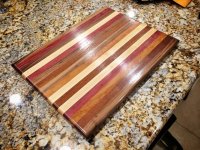hi all,
As the topic suggests, I have 4 or 5 end grain cutting boards to make. Previously I have rented time at the local woodworking shop for the projects, including paying extra for the drum sander time to flatten them. This is getting very expensive and a pain to drive out there each time.
I can now do everything I need in my home shop except for flattening them easily. My standard RO sander with coarse grit just gave up on me trying to flatten the first one.
Would the rotex be up to the job of easily flattening them? I also have a deck to refinish, but then the rest of the projects I have lined up for a while are smaller lighter projects. Would the rotex also be light enough to sand veneered ply as well?
Thanks!
As the topic suggests, I have 4 or 5 end grain cutting boards to make. Previously I have rented time at the local woodworking shop for the projects, including paying extra for the drum sander time to flatten them. This is getting very expensive and a pain to drive out there each time.
I can now do everything I need in my home shop except for flattening them easily. My standard RO sander with coarse grit just gave up on me trying to flatten the first one.
Would the rotex be up to the job of easily flattening them? I also have a deck to refinish, but then the rest of the projects I have lined up for a while are smaller lighter projects. Would the rotex also be light enough to sand veneered ply as well?
Thanks!


